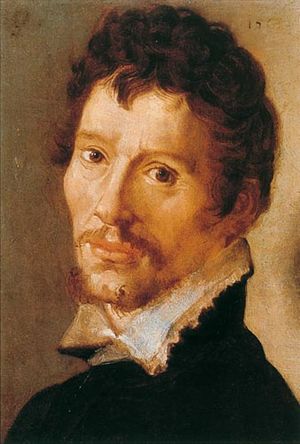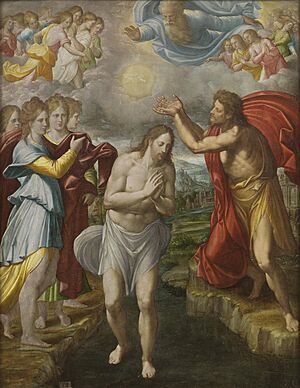Juan Fernández Navarrete facts for kids
Quick facts for kids
Juan Fernández Navarrete
|
|
|---|---|

Self portrait of Juan Fernández Navarrete (1563)
|
|
| Born | 1526 |
| Died | March 28, 1579 (aged 52–53) |
| Known for | Painting |
| Movement | Renaissance |
Juan Fernández Navarrete (born 1526 – died 1579) was a famous Spanish painter. People called him El Mudo, which means "The Mute" in Spanish. He got this nickname because he lost his hearing and ability to speak when he was a baby. Even without hearing, Navarrete became a very talented artist during the Renaissance period. He is known for his beautiful paintings, especially those he created for King Philip II of Spain.
Contents
Early Life and How He Learned Art
Juan Fernández Navarrete was born in Logroño, Spain, in 1526. When he was a baby, he became very ill. This illness caused him to lose his hearing, which also affected his ability to speak.
Even at a young age, Navarrete loved to draw. He would use a piece of charcoal to sketch things he wanted. This showed his early talent for art. He began learning art from a monk named Fray Vicente de Santo Domingo. He also studied with another artist named Becerra.
To learn more, Navarrete traveled to many famous cities known for art. He visited Naples, Rome, Florence, and Milan in Italy. In Rome, he met another artist named Pellegrino Tibaldi in 1550. Many people believe he spent a lot of time learning from the very famous painter Titian in Venice.
Working for the King
In 1568, Philip II of Spain invited Navarrete to Madrid. The king made him a royal painter and gave him a salary. Navarrete's main job was to create paintings for the Escorial, a huge monastery and palace that was still being built.
King Philip II needed many large paintings to decorate the Escorial. It was hard to find good artists for this big project. Titian was very old and died in 1576. Other famous artists like Tintoretto and Paolo Veronese did not want to come to Spain. So, King Philip II relied on Navarrete. The king liked Navarrete's "seriousness and good manners" in his art. For eleven years, until he died, Navarrete worked mostly on paintings for the Escorial.
Famous Paintings
Navarrete created many important works for the Escorial. One of his most famous paintings is a "Nativity" scene. In this painting, the light seems to come from baby Jesus himself, just like in a famous work by Antonio da Correggio.
Another well-known painting is the "Baptism of Christ", which is now in the Prado Museum. One of his last works, painted in 1576, is called "Abraham Receiving the Three Angels." This painting is now in the National Gallery of Ireland in Dublin.
Navarrete also painted many other large pictures for altars in churches. These paintings are known for their bold designs and rich, warm colors. Because of his beautiful use of color, people sometimes called him "the Spanish Titian." He passed away in Toledo in 1579, when he was 52 or 53 years old.
See also
 In Spanish: Navarrete el Mudo para niños
In Spanish: Navarrete el Mudo para niños


